When looking at the world in black and white takes a literal turn, and you soak your senses in the world of contradictions you find yourself amongst the works of Khalil Chishti and Adeel-uz Zafar. Works that defy gravity, intrigue without motion, and rapturously haunt you when you turn away. Such is the effect of works conceived and executed at the second Studio RM Artist Retreat Program 2024, and shown at O Art Space in Lahore, Pakistan. An initiative aimed at fostering positive change and bringing established artists and individuals within direct reach of an audience who would not have access to them otherwise.
Based on contradictions of love, life, and devotion, these artists challenge notions of our understanding of the world around us. They make you realize how we move through life without deliberate contemplation at times, while their art makes you anticipate life for a moment longer; all the while silently chipping away at our innermost fears is the work of New York-based Pakistani artist Khalil Chishtee and Karachi-based artist Adeel Uz Zafar’s showcased work.
Chishtee, known for his innovative sculptures and installations, explores themes of identity, memory, and the human condition. His recent works incorporate text and metal— drawing inspiration from Islamic calligraphy. These pieces are imbued with a fluid, mesmerizing quality, allowing viewers to appreciate the elegance and aesthetics of the script, even without the ability to read it. Through this practice, Chishtee interrogates the relationship between form and content, critiquing the reverence of form and icons as blind faith over the deeper messages that come with focused contemplation.
Adeel Uz Zafar is renowned for his meticulous engravings on vinyl and his exploration of themes related to childhood and memory. His recent works continue to delve into these subjects, offering viewers a profound reflection on the innocence and complexity of youth. Stuffed toys are wrapped in bandages made with the most delicate mark-making, silently and dotingly singing, what seems like, an ominous lullaby.
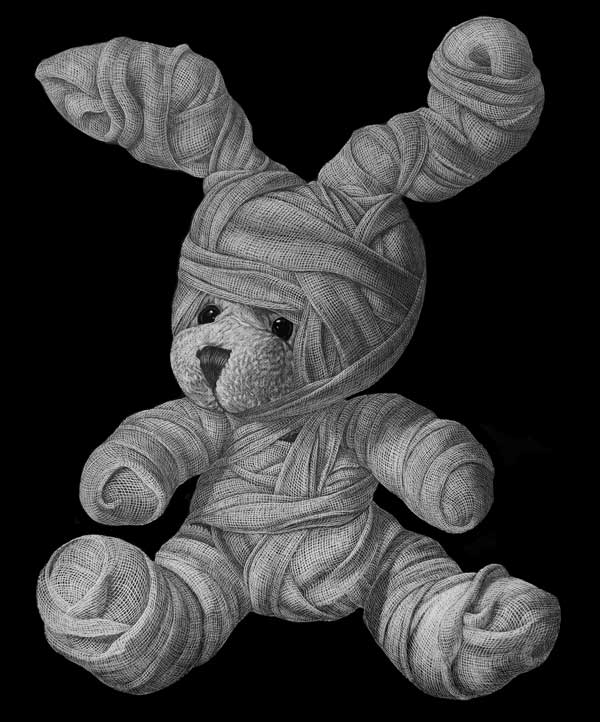
The two-person show by Chishtee and Zafar provided a unique opportunity for both artists to step out of their established workspaces in Karachi and New York City respectively, and engage in the Studio RM Artist Retreat in Lahore. This experience allowed them to explore and develop directions in their artistic journeys, which reflect the richness and possibilities of this immersive experience.
Chishtee’s practice embodies a deep engagement with themes of identity, personal narrative, and cultural commentary. Through various mediums such as sculpture, text, and mixed media, Chishtee explores the boundaries between self-expression and societal influence. When text appears through sculpture, taking the form of shields, swords, and objects evoking bodies and relationships, one instinctively assumes the work to be controversial. However, if you halt to read and contemplate the actual text used, you realize that the work begins beyond the biases that we carry. The work is personal and political but it is based off of Sufi poetry and stories from his own life, forcing one to drop all preconceived notions of how we experience the world. Making us, as viewers, more sensitive toward the world and how we receive information.
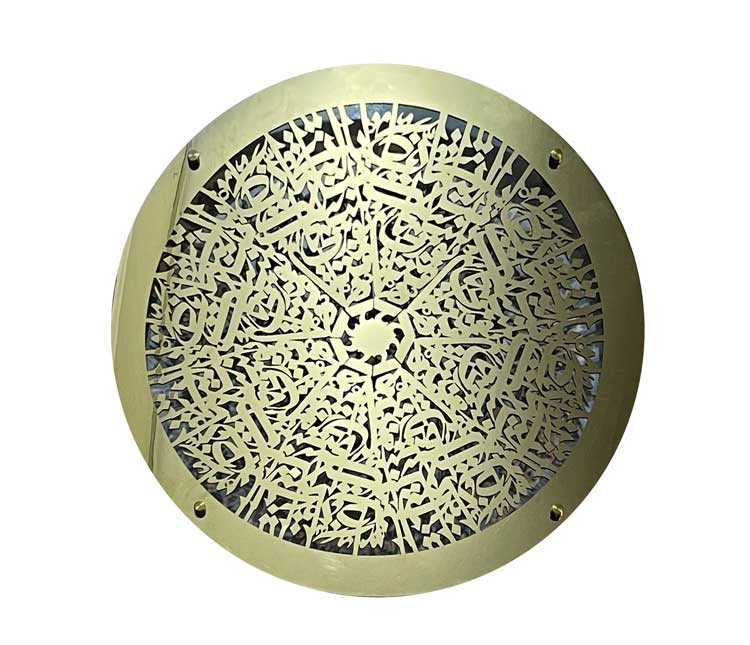
Chishtee’s approach to art centers on the belief that “every artwork is a self-portrait.” Art is a reflection of life, particularly his life and consequently the world around us as he expresses going through it. For him, artistic expression is intrinsically tied to personal concerns and life experiences. Whether working in the solitude of a studio in New York or Lahore, Chishtee’s creations capture a dialogue between his inner world and external realities. His work often transcends conventional forms, blending drawing, sculpture, and shadow play to explore new dimensions of storytelling. Chishtee underscores his physical engagement with art by focusing on the conceptual. This approach reflects a holistic creative process where intellectual, emotional, and physical elements converge into a thought-provoking element that keeps you on your toes.

The theme of exile looms large in Chishtee’s work, both metaphorically and literally. His exploration of displacement is poignantly captured in a piece inspired by Faiz Ahmed Faiz’s poem Mere Dil Mere Musaafir. When displayed, the sculpture’s shadows resemble charcoal drawings, reinforcing the idea of memory and permanence in the face of forced displacement.
Chishtee also reflects on cultural symbols such as swords, acknowledging their dual significance as emblems of both violence and peace. By engaging with these paradoxes, he encourages viewers to reconsider the narratives that shape cultural identity and history.

Strong advocates for community engagement, both Zafar and Chishtee led numerous artist talks during the retreat, including inner-city school programs. Valuing the power of conversation— seeing it as a means to exchange ideas, life concepts, and artistic visions. Their experiences in this artist retreat, which both described as “luxuriously designed” with readily available resources and educational outreach, have provided them with spaces for reflection and collaboration.
Adeel Uz Zafar highlighted a significant difference between this experience and previous outreach activities. However, this time the engagement expanded to include multiple institutional interactions, artist talks, and student participation from private, government, and numerous inner-city schools, along with smaller institutions eager for the rare exposure of conversing with artists they would not normally encounter— further enriching the experience.
Zafar’s creative process and artistic intent involved a conscious choice to work on smaller, time-bound pieces while exploring new directions within his practice. A recurring motif in the show was the “revealed eyes” of his subjects: the inanimate toys, wrapped in bandages yet leaving their button-eyes uncovered, suggesting a gaze that meets the audience directly, no longer a passive object. Eyes suggest a soul, and the soul of these toys appears innocent at first, yet their bandaged bodies move into realms of pain. Their identities are concealed through their wrappings, yet revealed in their near silhouette-like presence. They stand as symbols of innocence, battered and suspended on the edge of the human world. The gallery experience was designed to provoke thoughtful participation, with bandage-themed connotations deliberately woven into the works. Zafar described his final piece as intentionally incomplete, a gesture toward the beginning of new creative explorations.
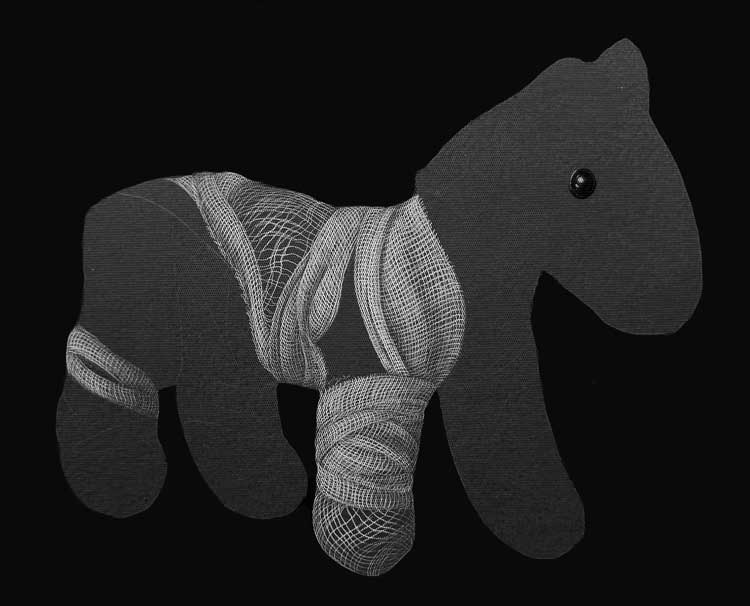
He expressed an interest in the dynamic relationship between individual artworks, posing questions about how these pieces “speak” to one another in a gallery setting. This led to the show facilitating an intergenerational collaboration.
The artistic approach was characterized by ambiguity, with black-and-white visuals that concealed deeper meanings, revealed gradually to the audience. However, despite collaborative efforts, Zafar emphasized that each artist retained a distinct creative vision. There was mutual agreement on presenting works together while respecting individual expressions.
As mentioned earlier, the residency stood out for fostering intense interactions between generations— a rare but productive occurrence. Senior artists like RM, Zafar, and Chishtee provided mentorship, while the younger generation and students brought fresh perspectives and energy. This polished interpretation captures the key insights, highlighting Adeel Uz Zafar’s thoughtful reflections on artistic practice, collaboration, and creative growth.
Zafar’s artist statement, an excerpt from T.S. Eliot’s The Hollow Men (1925), is a deeply symbolic and allusive poem that reflects themes of spiritual emptiness, paralysis, and despair in the aftermath of World War I. The poem blends religious, political, and literary references, creating a fragmented and haunting meditation on the condition of modern humanity. The poem consists of five sections, moving from a portrayal of the “hollow men” — figures who are spiritually and morally uninhabited— toward an apocalyptic vision of a world that ends “not with a bang but a whimper.” Eliot uses fragmented imagery and repetition to create a sense of desolation and decay. It introduces the hollow men as “stuffed men”, suggesting they are empty of meaning or substance. Their voices are weak and insignificant, reinforcing their lack of spiritual depth. Describing a barren, twilight world, a liminal space between life and death, this imagery alludes to Dante’s Inferno, where the souls who were indecisive in life are left in a meaningless existence. It suggests that the hollow men long for a lost paradise but are paralyzed by fear, unable to cross into a state of spiritual or moral salvation. The poem includes a fragmented prayer to a “broken” stone deity, emphasizing the failure of faith. Concluding with the famous lines, “This is the way the world ends / Not with a bang but a whimper,” suggesting that civilization is collapsing not through catastrophe, but through gradual spiritual erosion.
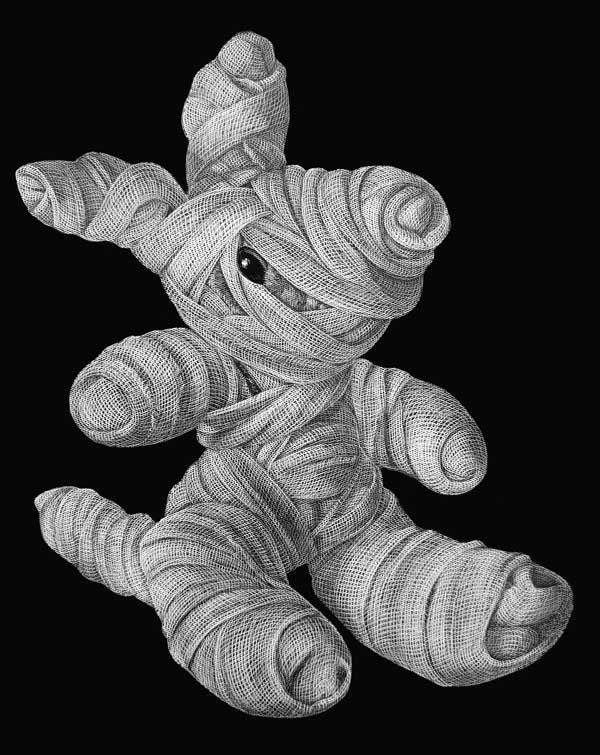
Zafar and Eliot’s “hollow men” are simultaneously characterized by their lack of conviction, passion, or purpose. They are neither fully alive nor completely dead, caught in an in-between state, reminiscent of purgatory. Eliot critiques modern civilization as spiritually vacant, echoing the themes of alienation. Eliot employs disjointed imagery, allusions, and repetitive phrasing to mirror the disintegration of meaning in the modern world. The poem reflects post-World War I disillusionment, showing a society that has lost faith in traditional values, religion, and heroism, referencing Dante’s Divine Comedy, particularly the souls in limbo who neither fully committed to good nor evil. The hollow men exist in a similar in-between space, fearing judgment but incapable of change. Existing as silhouettes without identities on the walls of the gallery.
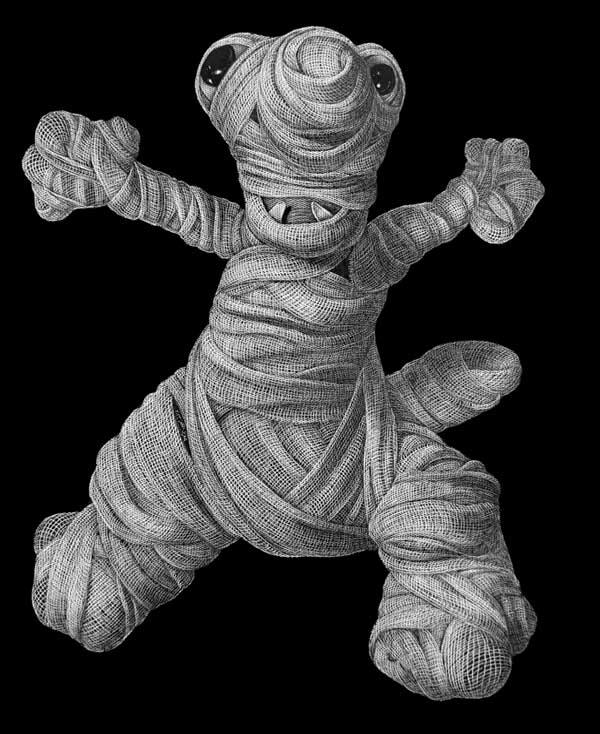
The famous closing lines contrast the dramatic apocalyptic imagery often associated with the end of the world with a quiet, anticlimactic demise. Eliot suggests that civilization is not destroyed by dramatic cataclysm but by slow spiritual decay and moral inertia. The Hollow Men is a bleak and powerful meditation on the emptiness of modern existence. Eliot presents a world devoid of meaning, where people exist in a state of paralysis, unable to take decisive action or find redemption.
On one hand, there is hope in the bandaged soldiers of Adeel’s apocalyptic world, their eyes opening to meet their voyeurs— no longer benign or merely receptive, but quietly provoking. On the other, Chishtee’s intertextual works resist their anticipated controversies, urging the viewer to reconsider their own role in perceiving the world through the immediacy of love and life. As different as these practices may seem, they refuse the simplicity of black and white. Instead, they guide us toward a realm where the collective conscience gathers beneath the umbrella of greys— where hope rises from the ashes of the lost, and stars burn brighter than the sun against a pitch-black night.
The two-person show “Adeel uz Zafar – Khalil Chishtee” initiative of the Studio RM Artist Retreat Program 2024, showcased at O Art Space, Lahore, from 27th December, 2024 till 7th January, 2025.
All images are courtesy of O Art Space.
Title image: Khalil Chishtee, Unbound, Powder Coated Metal, 30 x 24 x 2 inches, 2024
Hassan Munawwar
Hassan Munawwar is a tech consultant, who knows web, design, photography, and videography serving 1000 clients worldwide. He owns Commforce International and Clickogram.
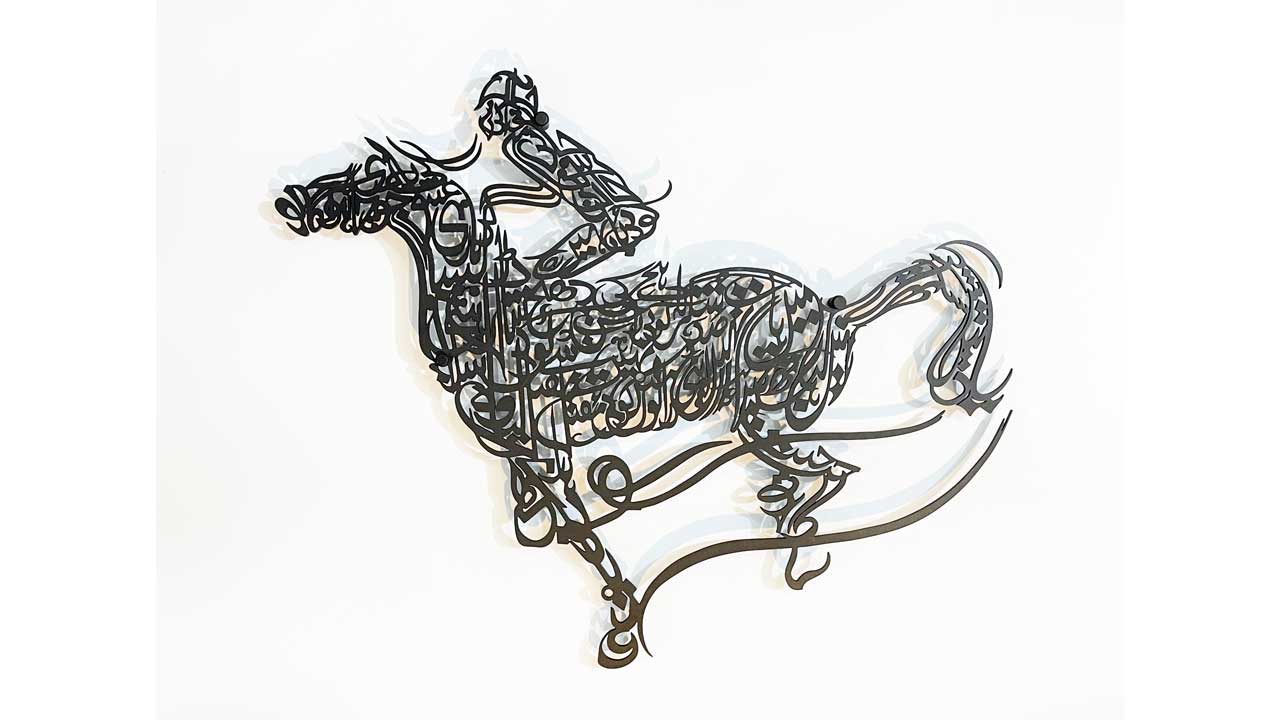


There are no comments